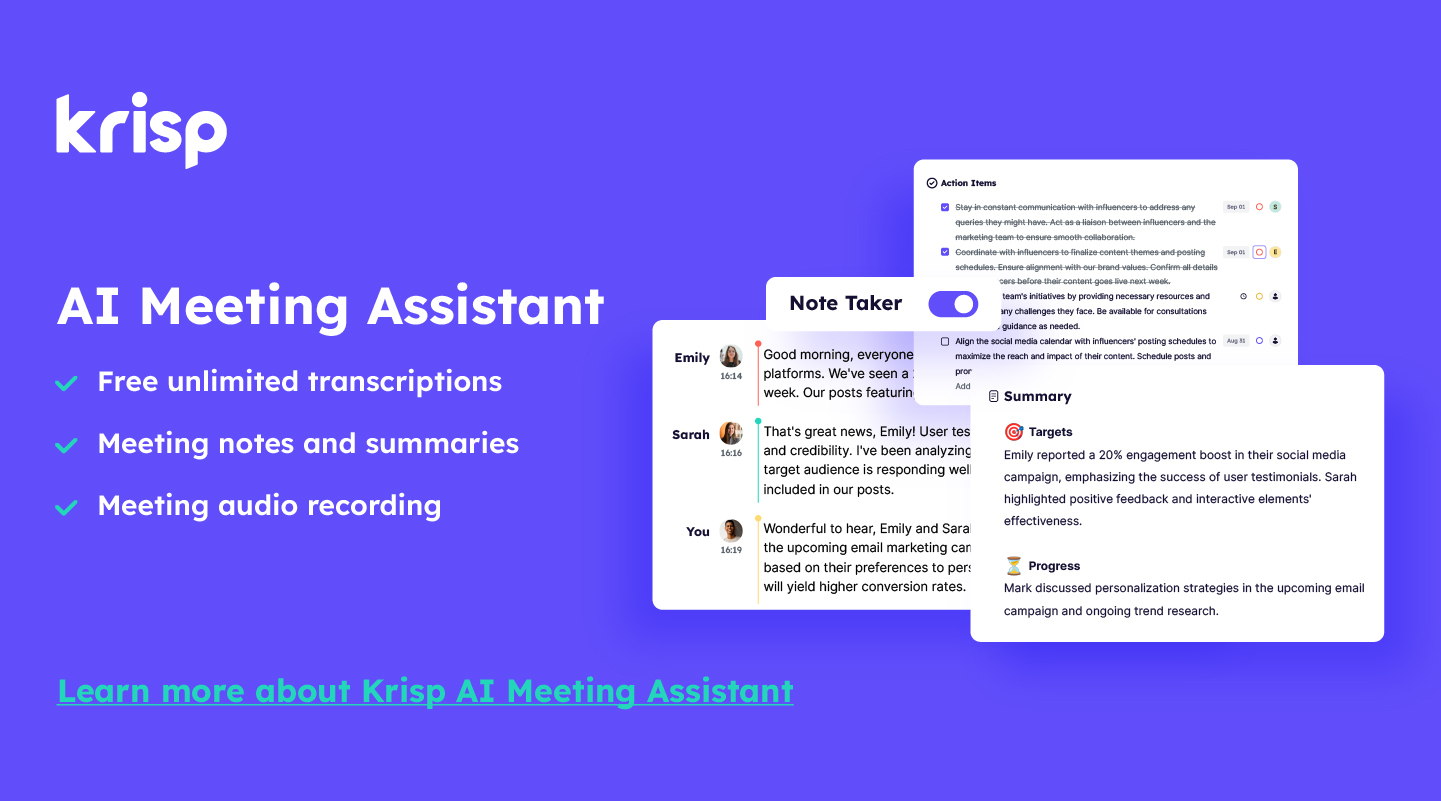The success of every company is built in the workplace; everything starts with the workplace culture. When leadership maintains a healthy and positive workplace culture and environment, the company’s chances of success are significantly increased. The question is how to maintain a positive environment in the workplace and how to improve workplace culture. In this article, you will learn many tips and tricks to build and maintain a positive workplace culture, such as fostering open communication, recognizing and appreciating good work, and using innovative tools like Krisp for better communication.
Workplace culture should also be maintained in virtual environments. Remote teams are just as important as traditional ones and have similar needs. The first and most important thing is communication, which should be crystal clear so other matters can be effectively discussed. Krisp is an excellent solution for virtual teams, as every meeting, brainstorming session, and team-building activity can be improved when you have Krisp installed.
What Is Workplace Culture?
Workplace culture refers to the shared values, beliefs, behaviors, and practices that define how people interact and work together in an organization. The workplace is like the root of a tree called the company. If the roots of the tree are healthy and in good soil, the tree will grow stronger and better over time. Working in a healthy environment with core values, open communication, and a sense of appreciation is what every employee seeks. If you can maintain such a workplace culture, it’s unlikely that your employees will leave the company during critical moments.
A positive workplace culture fosters inclusivity, collaboration, and mutual respect, while a toxic environment can result in disengagement, high turnover, and reduced productivity. Understanding the importance of workplace culture is the first step on the journey to success.
Why Is Workplace Culture Important?
Workplace culture is more important than many employers think. The inner culture affects the bigger picture of the company. In fact, how the workplace functions is similar to the situation of the company. If employees are motivated and organized, then the company is organized and successful. Employee engagement, retention, and every other detail directly depend on the company’s culture. A positive environment encourages teamwork, innovation, and accountability. In contrast, a toxic workplace culture can create stress, conflict, and dissatisfaction among employees.
Companies that have a healthy environment are more likely to attract new clients and achieve overall success. Every company has the chance to succeed if they start with building a healthy environment.
Examples of Workplace Culture
Here are two examples of workplace culture—one positive and the other toxic. Ultimately, it’s up to leadership to decide what kind of environment they want to create.
Positive Workplace Culture Examples

- Open communication where employees feel valued and heard.
- Recognition programs that celebrate accomplishments and boost morale.
- Flexible work policies that support a healthy work-life balance.
Toxic Workplace Culture Examples

- Micromanagement and a lack of trust in employees.
- Poor communication that leads to constant misunderstandings.
- A lack of recognition or appreciation for employees’ hard work.
Recognizing these examples can help companies take meaningful steps to build a positive workplace culture while addressing and eliminating toxic practices. Leadership sets the tone, and with intentional changes, a healthy, productive culture is always within reach.
How To Improve Workplace Culture
Building a positive workplace culture is hard but not impossible. Like building anything, this also requires dedication, consistency, and effort. When you build your dream environment, you will feel that all your efforts are justified. All you think about after building a workplace culture is finding ways to improve it and make it even better. Here are some practical strategies:
1. Foster Open Communication
Open communication will do the magic. Encourage employees to share feedback, ideas, and concerns without fear of judgment. Transparent communication builds trust and strengthens relationships within the team.
2. Lead by Example
Leadership sets the tone for everything. When leaders demonstrate empathy, integrity, and inclusivity, employees are more likely to mirror those behaviors.
3. Recognize and Reward Achievements
Acknowledging employee contributions boosts morale and motivates the team to perform better. Small gestures, like a thank-you note or public recognition, can go a long way.
4. Promote Work-Life Balance
Overworked employees are less productive and more prone to burnout. Offer flexible working hours or remote options to ensure employees can maintain a healthy balance between work and personal life.
5. Invest in Employee Development
Provide opportunities for growth through training, workshops, and mentorship programs. Employees who feel supported in their professional development are more engaged and loyal.
6. Address Toxic Behavior Promptly
Toxic workplace culture can quickly derail morale and productivity. Address negative behaviors immediately and create clear policies to prevent harassment, favoritism, or bullying.
How Krisp Supports a Positive Workplace Culture
Virtual reality brought virtual teams, tools, and also some challenges. Working remotely is all fun, but when it comes to maintaining a virtual workplace and having clear communication, challenges arise. Clear communication is the first thing that should be maintained for virtual teams, and here, the game-changing Krisp offers its Noise Cancellation tool, which creates an environment of understanding. By blocking out every noise, Krisp helps remote teams have open communication without worrying about clear audio.
Here’s How Krisp is Important in Your Virtual Setup:
Enhancing Virtual Communication
Krisp eliminates unwanted noise, allowing employees to focus on meaningful discussions without distractions. This clarity fosters better teamwork and ensures that all voices are heard. Clear communication is also very important for shy team members, as they may feel awkward having to repeat themselves over and over.
Boosting Productivity and Engagement
A positive environment thrives on engagement. When employees communicate effectively in virtual settings, they feel more connected and engaged in their work. Krisp helps teams stay focused during meetings, brainstorming sessions, and team-building activities, leading to better collaboration and improved decision-making.
Creating an Inclusive and Accessible Environment
Inclusivity is a key element of a healthy workplace culture. Background noise can be a barrier for employees with different working conditions, especially those working from home with family, pets, or other distractions. Krisp levels the playing field by providing crystal-clear audio for everyone, ensuring that remote and hybrid employees have the same quality of communication as their in-office counterparts.
Reducing Stress and Meeting Fatigue
Frequent virtual meetings with poor audio quality can lead to frustration and meeting fatigue. Employees often strain to hear or repeat themselves, which wastes time and lowers productivity. Using Krisp to eliminate noise disruptions, companies can make virtual meetings smoother and more enjoyable, reducing stress and improving overall workplace satisfaction.
Supporting a Stronger Remote Culture
A positive workplace culture isn’t just for in-office teams—it must also extend to remote employees. Krisp helps bridge the gap by making virtual communication as smooth and effective as possible, ensuring that all team members, no matter where they work from, stay connected and engaged.
Conclusion
A strong workplace culture doesn’t happen by chance—it’s built through consistent effort, open communication, and a commitment to creating a positive environment. Whether your team works in an office, remotely, or in a hybrid setup, workplace culture influences everything from employee engagement and productivity to retention and overall business success.
By fostering clear communication, recognizing employee contributions, encouraging work-life balance, and addressing toxic behaviors, companies can create a culture where employees feel valued, motivated, and connected.
For virtual teams, tools like Krisp play a crucial role in maintaining a seamless and distraction-free work environment. By eliminating background noise and enhancing virtual communication, Krisp helps teams stay engaged, collaborate effectively, and support a strong remote culture.
At the end of the day, a positive workplace culture isn’t just about making employees happy—it’s about building a foundation for long-term success. The stronger your culture, the stronger your company.
FAQ
Workplace culture refers to the shared values, beliefs, behaviors, and attitudes that shape how employees interact and work together within an organization. It influences everything from decision-making and communication to employee engagement and overall job satisfaction. A strong workplace culture fosters teamwork, inclusivity, and productivity, while a toxic culture can lead to disengagement and high turnover.
An example of a positive environment is a company that encourages open communication, recognizes employee achievements, and promotes work-life balance. Employees feel valued, teamwork is encouraged, and leadership supports professional growth. On the other hand, a toxic workplace culture might involve poor communication, micromanagement, and a lack of trust or recognition, leading to low morale and high turnover.
The four main types of workplace culture are:
- Clan Culture – A family-like, collaborative work environment where teamwork and employee well-being are prioritized.
- Adhocracy Culture – A fast-paced, innovative culture that encourages creativity, risk-taking, and adaptability.
- Market Culture – A results-driven, competitive environment where success is measured by performance and profitability.
- Hierarchy Culture – A structured and process-oriented culture with clear roles, rules, and a strong chain of command.
Each organization has a unique blend of these cultures, shaping how employees work and interact.
The key to a strong workplace culture is effective leadership, open communication, and employee engagement. Leaders set the tone by fostering trust, recognizing achievements, and promoting collaboration. A positive culture thrives when employees feel heard, valued, and motivated to contribute to the company’s success. Consistently reinforcing company values and creating a supportive environment are crucial to maintaining a thriving workplace culture.


